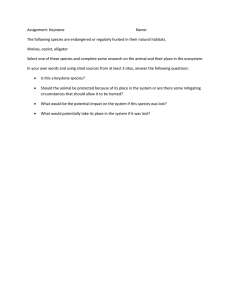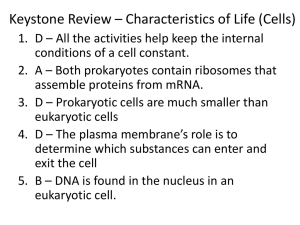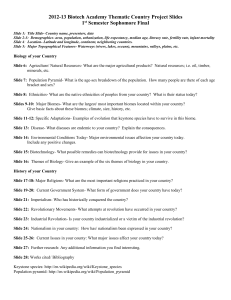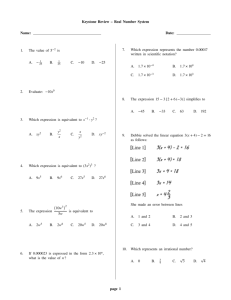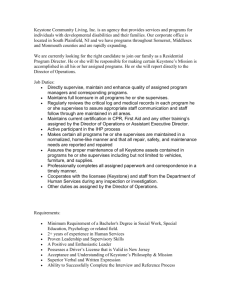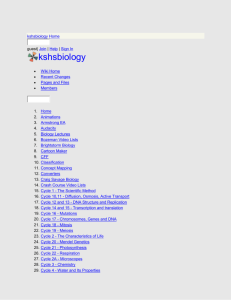by
advertisement
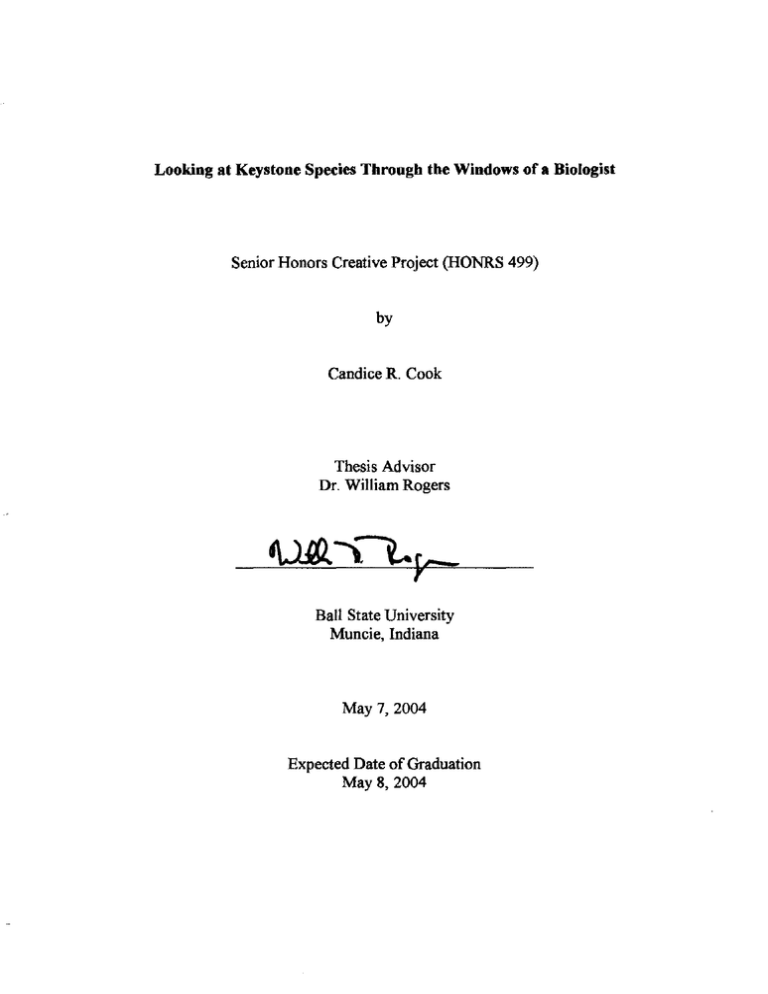
Looking at Keystone Species Through the Windows of a Biologist Senior Honors Creative Project (HONRS 499) by Candice R. Cook Thesis Advisor Dr. William Rogers Ball State University Muncie, Indiana May 7,2004 Expected Date of Graduation May 8,2004 Abstract: ,- '/ In this creative honors project, relief prints were made of animals that have been labeled in scientific literature as keystone species. This project provided a stimulus to further develop the skill of print making, enhanced the leaming of keystone species in a medium varying from normal scientific research, and provided an end product that can serve as an eye opener to get individuals to do further personal research on keystone species or relief printing. 1 Acknowledgements: I would like to thank my advisor, Dr. William Rogers, for his constant commitment to understanding that a biologist undertaking an artistic endeavor is an utmost challenge. In addition, I would like to thank MarydeUa Kamper for her everpresent encouragement and frequent questions on the progress of the project. She helped to keep the wheels of this project roUing and me on a diligent path to completion. Also, I would like to acknowledge Nathan Blank for the use of his digital camera. It allowed for much needed digital documentation of my creative endeavor. Furthermore, I would like to thank Dr. Sally Myers for introducing me to the relief printing process in her section of Honors 189 and Dr. Amy Sheaffer for providing me with the passion for keystone species research as spurred by her section of Honors NREM 101. 2 The Process. Relief Printing: After the topic of keystone species had been established as the information to be presented in the medium of linoleum relief printing, then the process of establishing prints could begin. To decide the keystone species that would serve as the subjects of my relief prints, I scoured ecology and biological journals. From this point, I located images of the subjects that I identified with and felt would lead to the positive portrayal of the keystone species in my prints. The images of the keystone species had to be developed into a drawing that was relevant to the size of the linoleum plate. This process utilized the located image, a sketchpad, a ruler to create the scale of the plate, various strengths of graphite pencils, and a knead eraser. The more effort placed into accurately depicting the details of the keystone species, the better guide the development creates during the carving process. Figure 1.1: The linoleum plate. *Reference: Appendix A. 3 Figure 1.3: The supplies needed to develop the image. Once the image was developed, the image was placed directly on top of the plate and traced via rubbing a hard lead graphite pencil on the backside of the drawing. This allows for the carving process to begin and the artist to gain licensure of the work. Figure 1.4: Tracing the image to the plate. 4 By placing a lot of emphasis on the development of the image, the carving process was made easier. The trace of the image allowed for me to decide whether I wished to carve the negative or positive space. It also served to show distinct fur and integument patterns that I used to more accurately present the keystone species. In the carving portion of forming the relief prints, Speed Ball ® blades of six varying gauge varieties were used. The differing blades allowed for me to choose different textures, depths, and widths of carvings to be established. I employed the narrowest blade most commonly to mimic the fur of many of the animals. In addition, for one print I added an Exacto-knife ®. In this carving, I wanted to totally eliminate any transition or interference space and, thus, create only positive and negative space. Advantageously, I used both the front and the backsides of the print block for carving surfaces. This allowed for one side of the print block to serve as a test surface for the carving tools. I utilized this in testing whether or not an imagined effect could be created with the tools at hand. The two sides were not exactly equal in texture, so the side with the finer texture was saved for the final print. Figure 1.6: Test surface ofthe print block. 5 Figure 1.7: My fmal carvings of the keystone species a tiger, a jaguar, a sea otter, a black-tailed prairie dog, starfish, salmon, and an elephant: *Reference: Appendix B. The carving process was by far the most tedious for me. Several of the carvings took two or three days to create the final product from the initial test carve to the printable carving. However, once the blocks were carved, the rewarding part of the process of making the print was finally upon me. 6 In a professional studio, the printing process would have been much more complex than the process I enacted. During printing, I first selected the ink color that would best heighten the characteristics within the print or had the closest resemblance to the animal in its natural condition. Figure 1.8: Water-soluble Speed Ball® ink. Figure 1.9: The ink roller. After rolling the ink onto the plate, a sheet of paper was placed on the inked print surface and prints were made. The quality of the prints was reliant upon the ink being evenly distributed across the surface of the block. The quality of the paper used also played a roll in the quality of the prints. Figure 1.11: The inked block. Figure 1.10: Rolling out the ink for print. 7 block. Figure 1.13: Smoothing the paper across the inked print block. The following are a few of the prints made as I attempted to find the best print color and quality from each block. (To view some actual print attempts, reference Appendix C.) 8 Figure 1.14: The sea otter. Figure 1.15: The salmon. 9 Figure 1.17: The jaguars. 10 Figure 1.18: The starfish. Figure 1.19: The black-tailed prairie dog. Figure 1.20: The elephant. 11 Figure 1.21: Me and a few of my prints. Presenting the PrintS: Once the prints had time to dry, I had to choose the best print from each block. The best prints were then mated with mat board that had been painted black to add contrast to the prints and bring out the fine details of the prints. The matted prints were then placed within the built and painted display, a white display board framed by 3 'x3' white windows. After the prints had been placed, the windows were dressed with blue curtains and a door was placed between the windows entitling the project. 12 Figure 1.23: A closer look at each window. Rationale: This creative project combined relief printing and the investigation of keystone species. Relief printing was incorporated into this project as a means for me to illustrate a biological topic in a new way to an audience. As a biology student, I have been taught how to explain points in lab reports, charts, graphs, and presentations. In this project, I chose to expand my horizons and attempted to use a new medium to illustrate a biological subject, keystone species. Relief printing, an artistic process, was introduced to me and briefly practiced in my Honors 189 course as a branching off of Japanese woodblock prints. The process, as outlined above, is time consuming and develops a subject from the drawing stage, through the carving stage, to the printing stage that creates the final print. The final prints can stand alone to display the significant characteristics of each keystone species. 13 However, together, they can be displayed to indicate the importance of keystone species in the field of biology. The display was formed to add emphasis and draw attention the prints. The black mat board that framed each print added contrast to the print itself. Additionally, the matted prints were placed inside white window frames. I choose to paint the window frames white to symbolize the purity of natural systems outside of the influence of man. Secondly, I placed a door in the center of the display with the project title. I choose to use this door as a symbol of the "door of knowledge" that was being opened to the viewers of the project about keystone species. Also, I incorporated the symbolic color blue in the curtains and on the door to represent the expression, "the sky is the limit" to the knowledge that the door is opening and the windows are presenting. Last, I place a red handprint on the doorknob of the door. This stood to symbolize that humans are redhanded. Many times keystone species are not identified until human have placed pressures on an ecosystem, and in turn, have shown the importance of a specific keystone species. I hope this display imparts people to analyze the following question, "So, what is a keystone species?" Keystone species are defined as species that, despite low biomass, exert strong affects on the structure of the communities they inhabit (Molles 483). In other words, these species are known to have a disproportionately large role in determining the overall community structure within an ecosystem (Ecorisk Fundamentals 9). These species are further defined in literature by the roles that they play. There are keystone predators, prey, mutualists, hosts, and modifiers. There are keystone predators like the tiger, the grizzly bear, the jaguar and others which control the 14 health and animal balances within their ecosystem (Miller 165, Mills, Scott, Micheal Soule and Daniel Doak 219). Keystone preys also exist and are exemplified by animals like the artic hare or the black-tailed prairie dog (Mills, Scott, Micheal Soule and Daniel Doak 220, Rosmarino 1). The keystone modifiers are species that actively modify and regulate the habitat within which they live (Miller 163, Mills, Scott, Micheal Soule and Daniel Doak 221). The elephant is a key example of a habitat modifier. The elephant as it makes its way through the grassland knocks over trees in order to forage off of the upper leaves of the tree. Once the trees are knocked over, other animals and aborigines use the paths created by the elephants and the waterholes created by the uprooted trees. The grasses of the savannah, in tum, are able to grow where the shade of the trees once prevented the grass to grow. Without the elephant, the grassland could potentially become a thicket or a forest eliminating the grass that many animals within the ecosystem depend upon (Miller 163, Kasnoff 1). Despite which type of keystone species category the keystone organism falls within, they are all argued to be important in biological and ecological terms. So, I could not place the emphasis of my project on anyone category of keystone species. Instead, I chose to illustrate the keystone species that were prevalent within the literature searches I had accomplished. These searches narrowed the species I illustrated down to the sea otter, the black-tailed prairie dog, the starfish, the tiger, the jaguar, the salmon, and the elephant. I felt that this was the best way to present the topic because if an individual went out to do further research on keystone species on their own, these would be the species they would have the most readily available resources on. 15 While this project was made to generate the response from the public, this project also provided an outlet for expressing my creativity and shaped a response in me as a biology student and future biologist. The outlet for my creativity allowed for me to perfect my skills in block carving. Entering this project I fumbled around with the carve tools, spent a lot of time on carving test prints trying to get ideas to work in print as wells as theory, and had little idea how to make a quality print. Leaving this project, I feel that I have a much better mastery in the range of capacity the tools create in carving relief prints. I also feel that the quality of my prints improved over time. From the creative perspective, I also found that the quality of my prints was limited by the quality of the supplies that fit within the budget of the project. Had more expensive tools been employed, the quality of the prints may have been increased. Yet, I don't feel that the quality of the artwork I produced was the sine qua non in this creative project. The true up shot for me was that I am now a more investigative and questioning biologist. Entering this project, I truly believed the keystone species were the cornerstones of many ecosystems and that they could serve as gauges for the quality of the ecosystems they lived within. I had this impression because I was taught the importance of keystone species in both an ecology course and in my Honors NREM 101 course. Leaving this project, I am left with the question, "Who is to decide what species is more important or plays a larger role within an ecosystem of counter-related species?" While I do believe that keystone species are highly important in educating the public in their roles within nature, I believe we humans need not place our full emphasis on saving those creatures we deem as important. More over, we should focus our efforts on trying 16 to maintain nature as it stands without our negative influence (as was argued by Mills, Scott, Micheal Soule and Daniel Doak). 17 References: Ecorisk Fundamentals: navy guidance for conducting ecological risk assessment. 27 Februrary 2003. <http://web.ead.anl.gov/ecorisk/fundamentals/index.cfm>. Kasnoff, Craig. "Elephants." Return to the Wild: vanishing. 2 July 1996. <http://www.bagheera.comlinthewildlvananimelephant.htm> . Miller, G. Tyler, Jr. Environmental Science: working with the earth. 9th ed. New York: Thompson Learning, 2003. Mills, Scott, Michael Soule, and Daniel Doak. "The keystone-species concept in ecology and conservation." BioScience. 4 (1993): 219-225. MoUes, Manuel C., Jr. Ecology: concepts and applications. New York: McGraw Hill, 1999. Rosmarino, Nicole. Prairie Dogs Are a Keystone Species of the Great Plains. <http://www.groc.org/Keystone species.html>. 18
